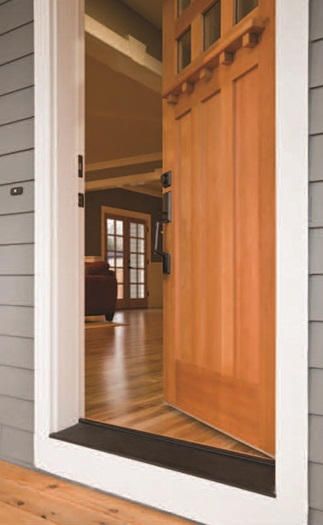Your front door matters a lot more than you think.
By Mark Stewart
My first job out of college in the early 1980s was a sales position and the first thing I was told by my manager was to buy a decent pair of shoes. A customer, he explained, is most likely to decide what kind of person you are and what kind of product you’re selling by the quality, condition and style of your footwear. My $20 Thom McAns, in other words, weren’t going to cut it.

Upper Case Editorial
For whatever reason, I didn’t last long in sales—the company happened to be the one Glengarry Glen Ross was based on (second place is steak knives, third place you’re fired) so I count myself fortunate. I’m not sure I ever entirely bought the shoes idea. However, I do believe something similar applies to a home’s front door. The choices you make related to the entrance of your home can say as much or more about you than the cars you drive, the clothes you wear, the school your kids attend or all of the other traditional clues about substance, status and taste.
Think about the last time you attended a party at a new friend’s house, or went home- or apartment-shopping. Aren’t you guilty of passing judgment on what’s inside based on what’s outside? It really is human nature to judge a book by its cover, despite the idiom that says you can’t. So I’ll say it: Your front door matters
According to the Internet, which as we know is right about everything, the average American will own three homes in his or her lifetime. That means, statistically speaking, if you’re on your first home, then you’ve got two more front-door decisions left. If you’re on your third home, well, you can probably skip to the next story. But wait! You can always shop for a new door—in fact, many people do. Which is kind of the point of this article. It’s a fact, in fact, that not everyone sticks with the front door that “came” with their current abode. As with other parts of a home, there’s always impetus for change or room for improvement
I have owned two homes and was fortunate that each one came with a magnificent and unusual front door that would have cost somewhere in the high four figures to duplicate. Fortunate because my spouse (who as a juror would be more likely to convict on the basis of a cheap, ugly front entry than on the basis of criminal evidence) would not have allowed us to move into or, perhaps, even buy our two homes had the doors not checked all of her boxes. As a side note, I have been endlessly amused when I catch people staring at our doors and wondering what kind of freaks live in our house. I mention this only to underscore how very personal a choice it is that we make when we choose a front door
If you actually are in the market for a new door, or maybe just considering a different look, you don’t have to drive through too many neighborhoods to realize that there are a dizzying number of sizes, styles, materials, colors and hardware. Sometimes you’ll see a wow-factor entrance on an otherwise ordinary home. Sometimes you’ll see an utterly featureless front door on a really interesting house. Then there’s that door with a splash of color that’s maybe trying a little too hard. And of course, the door that announces to the world that you don’t care and, by the way, mind your own business. Which is also a choice, in its own way, I suppose
I once talked to a builder who claimed a front door should be like a baseball umpire: you know it’s doing a good job when you don’t notice it at all
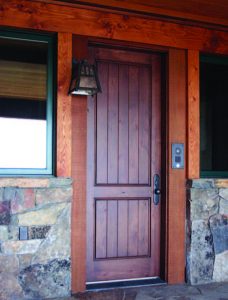
High Sierr Custom Door
The basic material choices for a really good-quality front door include metal, fiberglass and old reliable wood. As wooden doors go, it’s difficult to go wrong with mahogany. It is substantial, durable and resistant to insects and rot. Another wood that is popular in areas where insect life is abundant is cedar, which actually repels wood-eating bugs and is full of natural preservatives. It also has an aroma that most people like. Oak is a popular wood for similar reasons, while cherry is known for its strength, density and ability to hold its finish. That’s why cherry is a popular wood for kitchen cabinetry
Round and Round

Upper Case Editorial
In 1881, a German company introduced the concept of a revolving door, which was meant to solve the problem of winter drafts and summer dust getting into commercial lobby spaces. In 1888, a Philadelphia inventor named Theophilus Van Kannel patented the three-panel revolving door, which made him a wealthy man. He also designed amusement park rides at Coney Island, which is probably why small children love to play in revolving doors…or are utterly terrified by them.
In terms of whether to stain or paint your wooden front door, the argument for staining is that it shows off the natural beauty of the wood. Painting gives you an infinite number of color choices, of course, and also offers added durability. The main argument against staining is that a natural-wood door with a lot of direct sunlight may need a fair amount of maintenance, whereas a painted door is likely to hold up better over the long haul. If you know for sure that you’ll be painting your new wooden front door, you can also get away with a less expensive grade of wood

Upper Case Editorial
Wilt’s Place
When Wilt Chamberlain played basketball for the Los Angeles Lakers, he built a glass-walled mansion atop an old WWII anti-aircraft emplacement in Bel Air. The home featured a 14-foot rolling slab of redwood as the front door—supposedly it contained enough wood to frame 17 small homes. He claimed there was no need to lock it because he was the only one strong enough to open it. Gotta love Wilt.
The roller idea was cool, for sure, but also a nod to the realities of gravity. There may not be a side hinge on earth that could bear that weight. The lesson here is that traditional door hinges come with a weight limit, so when choosing hardware, know the weight of your door. An inexpensive door runs just over one pound per square foot, but an oversized oak door could weigh as much as 150 to 200 pounds.
STEPPING INTO THE
Before we move on to other materials and options, let’s do a quick dive into the history of the door. Logic suggests that doors have been with us since humans moved from caves into constructed shelters. That’s not entirely accurate, in the sense that for many millennia, the typical front door was really just a couple of layers of animal hides. Hinged or pivoted doors that swing smoothly open and closed (what we all think of as proper doors) are probably less than 5,000 years old. Archaeologists have found evidence of functioning doors in ancient Egyptian tombs and temples throughout the Middle East, as well as paintings of doors at burial sites, which presumably were meant to represent a passageway to the afterlife. These ancient doors were made of wood or stone, depending on their purpose and available materials. It appears that wooden doors were also being used in Europe around this time
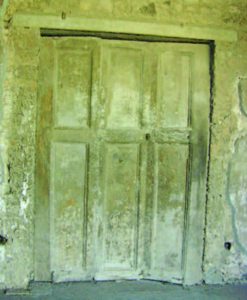
Barbara McManus VRoma Project
The Romans took doors to the next level, using various metals, including bronze, and even creating sliding and folding doors. They actually had a God of doors, Janus, who also covered archways—another architectural specialty of the empire—as well as broader symbolic concepts, including beginnings, endings, time and duality. Roman sculptures of Janus often depicted him as having two faces looking in opposite directions. A small temple, the Janus Germinus, was located at one end of the famous Forum, and was depicted on a coin minted during the reign of Nero in the first century. At about the same time, during Rome’s occupation of Egypt, a Greek engineer known as Heron of Alexandria, designed an “automatic” door. Heron was quite the inventor. He is credited with developing the first steam-powered engine, the first windmill and the first vending machine

Guillaume Piolle
Doors became especially important after the fall of Rome, when order gave way to chaos (or so we are meant to believe). The Dark Ages actually weren’t as bleak as they sound, but a good, solid door was definitely important—whether you owned a castle or just a modest home. For large structures, such as forts and cathedrals, Medieval architects favored oak as a material, joining layered planks together with metal reinforcement bands and fashioning heavy iron strap-hinges that functioned for centuries before wearing out. The wealthier or more important the home- or castle-owner, the more elaborate the door and doorway were likely to be
During the Renaissance, front doors became canvases for skilled craftsmen and often reflected the artistic traditions of different countries and regions.
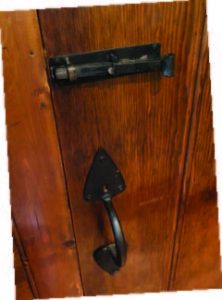
Upper Case Editorial
Michelangelo described the heavily adorned doors of Tuscany as “gates to paradise.” The entrances made for French cathedrals were perhaps the most elaborately conceived doors and doorways in history. These monumental passages were often left open during the day to let in light and air, and then “locked” at night with a big, wooden or metal bolt that fit into or slid across an iron bracket. Mortice locks (a lock system cut into the door and door jamb) were fairly rare at this time for exterior doors
From a technological stand-point, doors and doorways didn’t change much after this. Windows were incorporated into exterior doors in places where the chances of an attack were remote. In the 1700s and 1800s, interior doors began to find their way into everyday homes. Prior to that, families tended to live in one
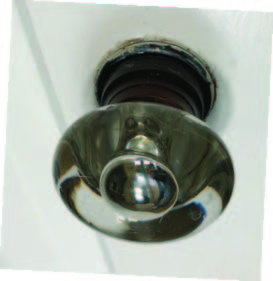
Upper Case Editorial
large, partitioned room. Doorknobs, door handles, door latches and other durable “modern” hardware began appearing during the Industrial Revolution, both in the U.S. and abroad. These finished goods were expensive prior to the days of mass production; in modest homes, doors were operated by pulling on a leather strap attached to a wooden drop-latch that was threaded through a hole in the door. In the latter part of the 19th century, during the Victorian Era, ornate hardware such as ceramic, brass or mirrored mercury-glass knobs came into vogue

Upper Case Editorial
One Good Turn
The modern lock-and-key set
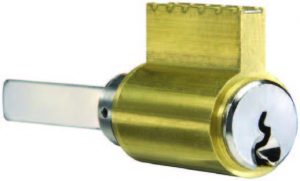
Craftmaster
, unveiled by Linus Yale in 1848, is called a pin tumbler (or cylinder) lock. His son, Linus Jr., improved on this design in the 1860s. Since then, door locks have remained essentially the same, while most door keys have looked pretty much like the ones you see hanging on displays at your local hardware store. Here’s the Yales’ little secret: They actually built their empire on a concept originated in the 1780s by Englishman Joseph Bramah, a prolific inventor whose crowning achievement was the hydraulic press, a technology still in use today
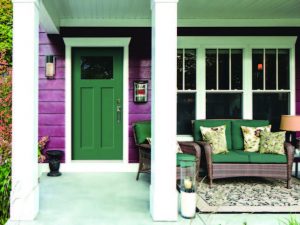
Jen-Weld
OTHER MATERIALS
Okay back to the 21st century. Wooden doors are not for everyone. From a maintenance, security and energy efficiency standpoint, a metal door (below) might be a better choice. The industrial look is very popular now, too, so for certain modern homes, wood doesn’t make a lot of sense. One crucial caveat about a metal door is that it either must fit the existing framing exactly, or you’ll have to rip out the entire front entrance. Hanging a new metal door on an old frame is asking for trouble; remember, you can’t plane down metal if it rubs or sticks somewhere. In terms of durability, metal doors are great but they don’t necessarily last a lifetime. Depending on how they are constructed and the climate conditions they face, even the most expensive steel doors can “peel” over time. They can also be marred or dented, which is difficult to repair and can invite rust.
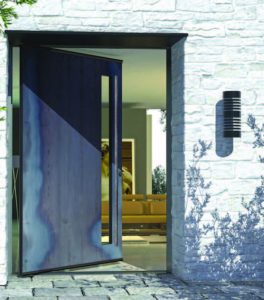
Modern Steel Door Co.
So what about fiberglass? Well, a fiberglass front door (above) would be a deal-breaker for my wife, but I wonder if she could honestly tell the difference between painted wood and top-quality painted fiberglass from more than a foot or two away. (I’m sure I’ll find out before she even finishes this story). I’m just saying “wood-grain” fiberglass products can look pretty convincing, if you ask me. The main drawback of this material is that it’s not one of the other two materials. The pros of fiberglass are many. Fiberglass doors have great insulating properties, they are more scratch- and dent-resistant than metal, and they have a similar “feel” opening and closing as wood does.
If you’re keeping score, here’s where we are: fiberglass is best from an upkeep standpoint, metal (steel) is the best for strength and security, while for most people wood holds the aesthetic advantage.
Price-wise, there are significant differences. A big, beautiful wood door can run $5,000 or more. Because they do absorb moisture, wood doors also need to be sheltered from the elements, under a porch or portico, so there may be an added expense there. Our current front door is almost four feet wide and nearly eight feet tall. It is magnificent. It is priceless. It is one-of-a-kind. However, on a humid summer day, you need to put your shoulder into it to get it all the way closed.
A top-of-the-line thick-gauge steel door will run you less than half of a comparable-quality wood door, although it’s not really fair to compare them. As I mentioned earlier, the cost may rise significantly based on what you’re replacing and the condition of the door jamb and surrounding framework. You also need to hire someone who’s done a bunch of them, and done them well. You don’t want some jack-of-all-trades learning on your dime.
Fiberglass comes in somewhere between steel and wood, even though you’ll see some advertised at bargain prices. Trust me, they are no bargain. You want a door you won’t have to think about for 20 years, and that may run you $2,000 or more installed.
One final word of advice: Be smart about choosing your installer. If you are undergoing a wallet-ectomy to buy a top-quality manufactured door, regardless of the material, give a lot of thought to who is installing it for you. Most of the top brands have trained or certified contractors to deal specifically with their doors. Really, they do. So even if you have a favorite carpenter or handy-person, you might want to look at a list of recommended installers.
What about the DIY route? Well, many years ago, I attempted to install a brand-new kitchen door in a very old house. I was young and stupid (in other words, still in my 20s) and figured a rectangle is a rectangle, a tape measure is a tape measure…how hard could this be? That door never closed without emitting the same exasperated groan my wife did the day I announced I could “do it myself.”
Later, when we were selling the house, I could sense that the prospective buyers were spending a lot of time looking at that door and wondering what else I had “fixed.” I learned my lesson: When it comes to doors, skip the Thom McAns and go for the Ferragamos. It is money well spent.

